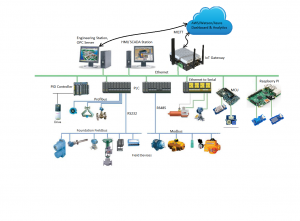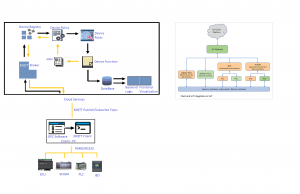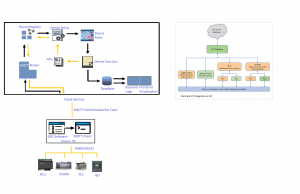Architectural Approach of PLC Integration
Overview
For IIoT implementations, one of the first hurdles is at the point where it all starts – the collection of data from the machines, instruments and sensors. (Also, it can be said to end here – with control of actuators and machines!) Most of the machines, especially in small and medium manufacturing enterprises, are not IoT capable yet. Thanks to the previous industrial automation revolution those are equipped with sensors and even programmable devices in the form of Programmable Logic Controllers (PLCs). However, these are still mostly stand-alone setups with zero to local-only connectivity. The Distributed Control Systems (DCS) and Supervisory Control and Data Acquisition (SCADA) systems could be interconnected to form a larger network. But such systems cover only a single plant or factory with no capability to exchange data with the external world. Their integration with the IoT world requires external hardware and software, like a gateway or OPC UA.
Completely replacing such legacy systems with the new age network-enabled systems could be the fastest way to adopt industrial IoT. But the cost and efforts associated with this would be a strong deterrent for widespread adoption. A cheaper and more acceptable approach would be to either upgrade such machines for IoT connectivity or device intermediate mechanisms (like gateways) that could facilitate indirect integration with the IoT world.
Use Case
Provide simple, cost effective way of PLC integration with cyber world in order to real time monitor the solution, perform remote device diagnostics and generate predictive alerts.
Industrial IoT Architecture

1. PLC and Gateway Integration
PLC generally have only the standard hardware interfaces or connectivity mechanisms. Getting such PLCs connected into the Industrial IoT is a real challenge because of the plethora of interfaces (RS-232, RS-485, RS-422, Ethernet, etc.) and protocols (Modbus flavours, Ethernet/IP and other proprietary protocols). In some cases, the PLC vendors offer add-on communication modules to enable the network connectivity. In other cases, one may need to use a device that acts as a bridge or a gateway to handle PLC specific communication on one side and the cyber world communication on the other side.
Such gateways are available commercially from many companies (e.g. Kepware, Advantech, to name a few and others), with a variety of features and price-points. For a medium to large deployment, this could provide an easy, fast and cost-effective path. For small (and smaller!) setups, however, the gateway costs may start getting closer to the alternative of replacing existing older PLCs. For such cases, it could be worth exploring the option of building custom, low-cost gateways that are capable of just supporting a specific set of PLCs. Considering open-source implementations of OPC standard could be useful here.
Architecture

Working
The sensors communicate to PLC over different protocols like Profibus, DeviceNet, Modbus etc. Now the data is locally available within the Factory. To get the data out in the web world, there is a need of physical device called as “Gateway”. The Gateway will communicate to PLC over one of the Modbus flavours for example Modbus TCP/IP network. The Gateway is responsible for functionality like secure data transfer, aggregation, filtering, edge analysis etc. The Gateway does signal conditioning and route it to cloud using MQTT protocol.
On cloud below operations are performed on the data.
- Data forwarding based on Policy
- Data massaging and routing based on IoT Rules
- Function to update the sampling rate
- Data storage
- Rules for threshold alerts
- Virtual machine to deploy front-end and back-end
The data is showcase on Dashboard for visualization and also feed to algorithm for Data analytics. The alerts are provided on dashboard to end user based on the machine parameters monitored.
2. PLC and OPC UA Integration
Most of the modern PLCs (except the entry level ones) have built-in Ethernet connectivity or could be augmented by using add-on Ethernet communication modules. Many PLC manufacturers employ proprietary protocols within their own ecosystem and this makes direct integration of PLCs from different vendors into a larger control system difficult. This known problem can be solved with the OPC (Open Platform Communication, also known as OLE – Object Linking and Embedding- for Process control) standard based software (client and server) as it enables PLCs from different vendors to communicate with each other.
OPC Unified Architecture (OPC UA) is a vendor-independent communication protocol for industrial automation applications. It is successor of OPC (next generation OPC protocol) and is based on the client-server principle and allows seamless communication from the individual sensors and actuators up to the ERP system or the cloud. The protocol is platform-independent and features built-in safety mechanisms. Since OPC UA is flexible and completely independent, it is regarded as the ideal communication protocol for the implementation of Industry 4.0
Architecture

Working
OPC UA is installed on any server grade machine as software component. OPC run as a background process and do the data exchange, both read and write. An OPC can directly talk to the field devices such as PLCs, HMIs and PACs. OPC connects only with digital devices that do not include in 4-20mA devices. On the same server grade machine MQTT client is installed. Which uses MQTT protocols to communicate with cloud services.
Benefits of OPC
- Integration costs will be reduced because all software and hardware components are there to a single, standard communications protocol.
- OPC servers will replace proprietary I/O device driver software for their hardware.
- OPC will provide a single, consistent communication interface so that software suppliers can focus on adding new features to their software instead of developing along the list of proprietary hardware device drivers.
- DCS, SCADA, HMI, plant scheduling, maintenance, and other applications can act as OPC clients and servers to permit data exchange between cooperating applications
Operational Impact
- Remote Device Diagnostics – Real-time status reports enable maintenance personnel to do predictive maintenance and problem detection before interruption in production processes.
- Total Cost of Ownership – Total cost of ownership is lowered due to reduction in unexpected maintenance costs.
- Real-time Tracking – The location of individuals and assets can be identified in near real-time.
Summary
To summarize, this approach can be considered as stepping stone for Industrial IoT integration. Because the selection will vary based on parameters like use case requirement, cost, support, resource skill set, time to market etc.



